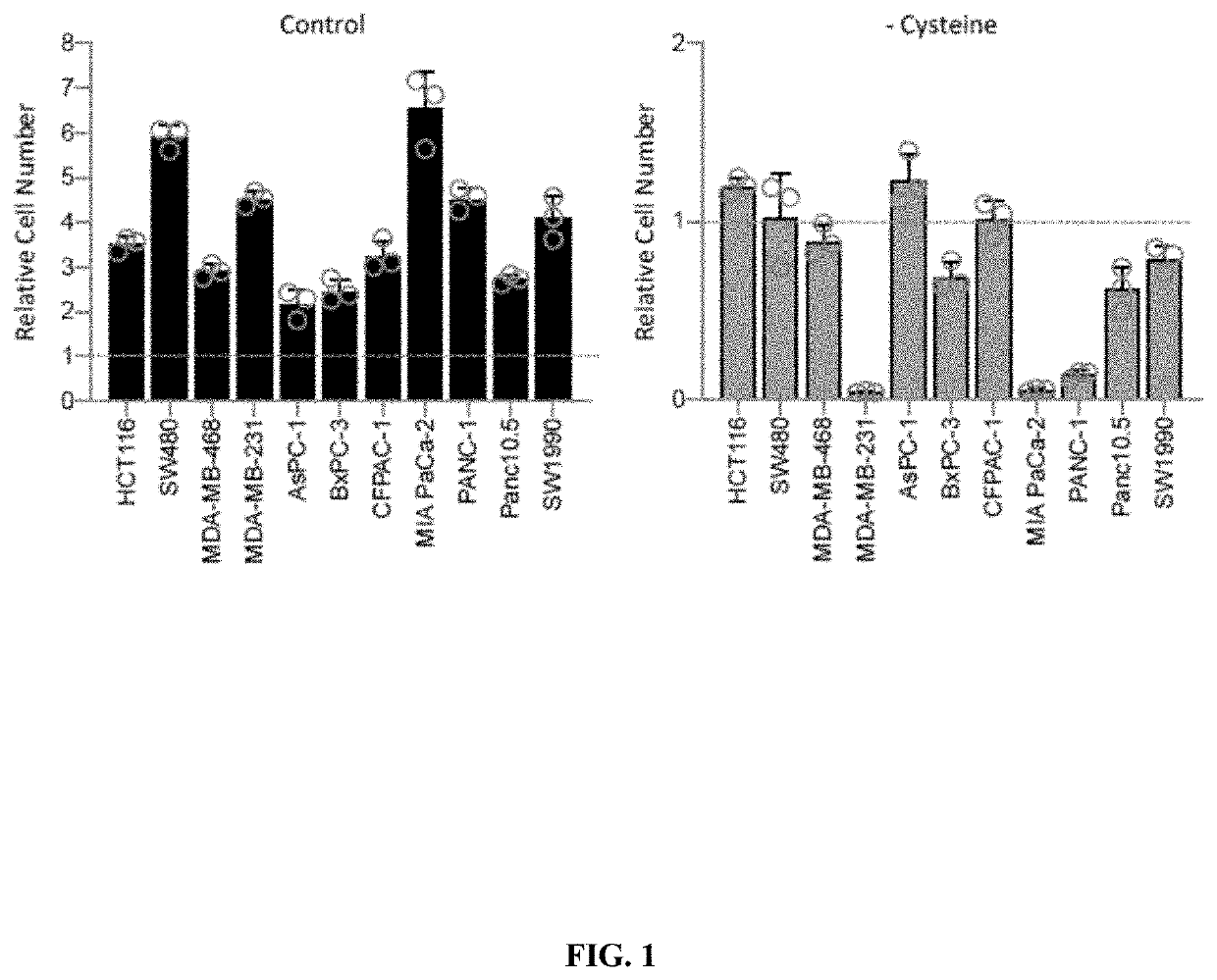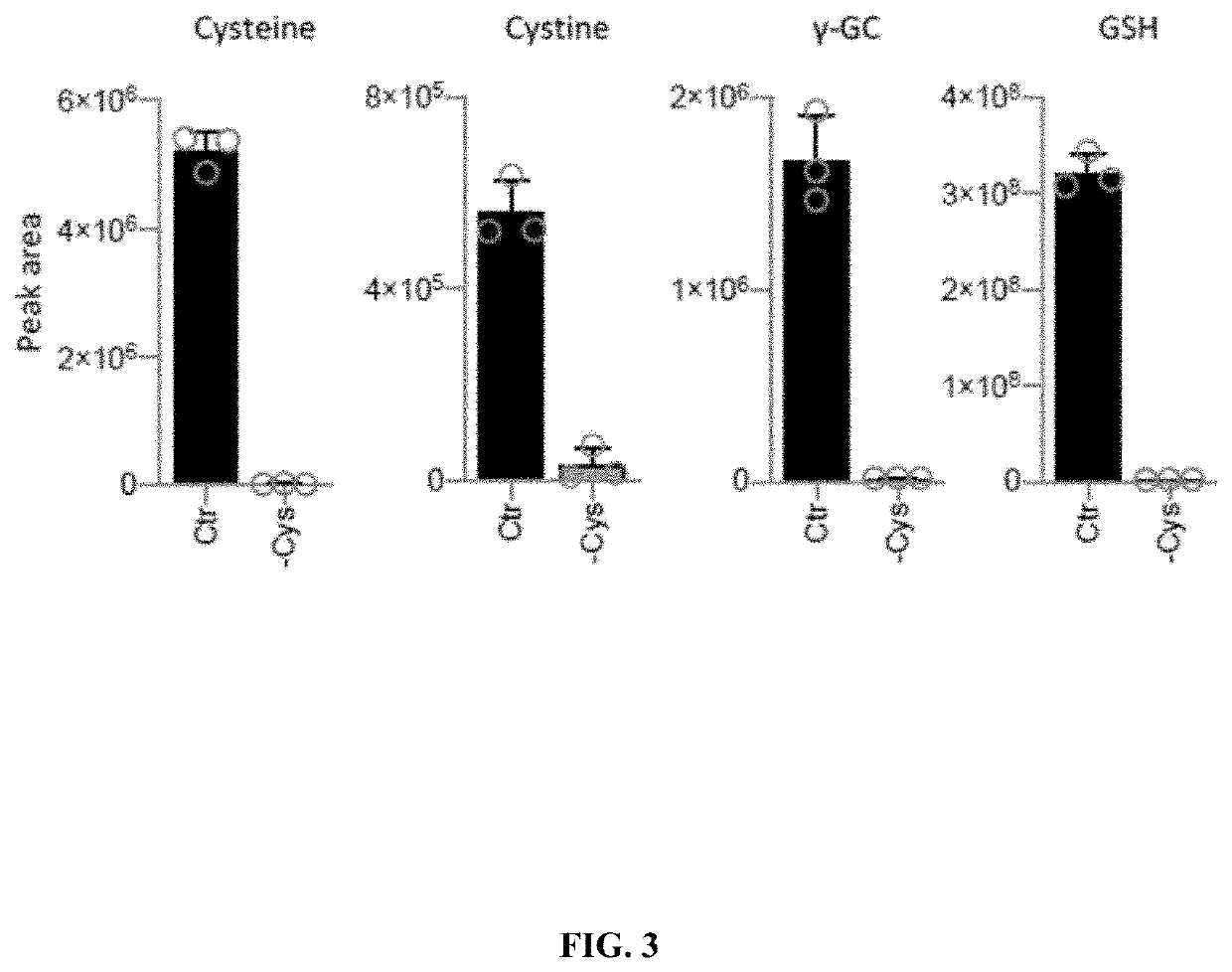Personalized methods of treating cancer
a cancer and personalized technology, applied in the field of personalized methods of treating cancer, can solve the problems of preventing cancer cell proliferation and cell death, and achieve the effect of reducing cancer cell proliferation and downregulating 5-methylthioadenosine phosphorylas
- Summary
- Abstract
- Description
- Claims
- Application Information
AI Technical Summary
Benefits of technology
Problems solved by technology
Method used
Image
Examples
example 1
tal Methods
[0215]a. Cell Culture
[0216]HCT116, SW480, MDA-MB-468, MDA-MB-231, AsPC-1, BxPC-3, CFPAC-1, MIAPaCa-2, PANC-1, Panc10.05, SW1990, U-251, LN-18, LN-229, T98G, U-343, A-172 cells were used. Cell lines were authenticated using Short Tandem Repeat (STR) profiling and tested for mycoplasma. Colorectal and breast cancer cell lines were grown in Dulbecco's Modified Eagle Medium (DMEM), pancreatic ductal adenocarcinoma (PDAC) cell lines were grown in Roswell Park Memorial institute (RPMI) 1640. All cell lines were supplemented with penicillin-streptomycin, amphotericin, 2 mM L-glutamine, and 10% fetal bovine serum (FBS). Cells were kept at 37° C. in 5% CO2 in a humidified cell culture incubator. A formulated medium lacking cysteine, cystine, methionine, and serine was used as a base for creating experimental media. The base medium formulation contained 0.2 mM L-histidine, 0.4 mM L-isoleucine, 0.4 mM L-leucine, 0.4 mM L-lysine, 0.2 mM L-phenylalanine, 0.4 mM L-threonine, 0.08 mM L-...
example 2
Sensitivity to Cysteine Starvation
[0236]A panel of cell lines consisting of colorectal (HCT116 and SW480), breast (MDA-MB-231 and MDA-MB-468), and pancreatic cancers (AsPC-1, BxPC-3, CFPAC-1, MIAPaCa-2, PANC-1, Panc10.5, and SW1990) were used to assess the impact of cysteine starvation on a range of cancer cells. In all experiments, where cysteine was removed, the homo-dimer cystine was also absent.
[0237]FIG. 1 shows the effect of cysteine starvation (−Cysteine; RIGHT PANEL) on cell proliferation compared to fully fed conditions (Control; LEFT PANEL). After three days of cysteine starvation, all 11 cell lines showed severely impaired proliferation compared to fully fed conditions. Several cell lines maintained approximately the same cell numbers during starvation (e.g. HCT116, SW480, MDA-MB-468, and AsPC-1), indicating that the cells had survived. Other cell lines, particularly MDA-MB-231, MIAPaCa-2 and PANC-1, had a relative cell number (versus the starting cell number) below one, ...
example 3
itivity to Cysteine Starvation does not Correlate with Transsulfuration Pathway Enzyme Expression, and is not Rescued by Excess Methionine
[0242]The relationship between response to cysteine starvation and expression of TsP enzymes for de novo cysteine synthesis was investigated (FIG. 5). Scatter plots comparing enzyme expression versus cell number after cysteine starvation show that there was no correlation between starvation response and expression of S-adenosylhomocysteine hydrolase (AHCY), cystathione β-synthase (CBS), or cystathionine γ-lyase (CSE).
[0243]FIG. 6 shows scatter plots comparing enzyme expression of S-adenosylhomocysteine hydrolase (AHCY); cystathione β-synthase (CBS); cystathionine γ-lyase (CSE); or CBS+CSE versus cell number after cysteine starvation. FIG. 24 PANEL A shows colorectal (HCT116 and SW480) and breast (MDA-MB-231 and MDA-MB-468) cancer cells were either grown in complete medium containing all amino acids (Ctr) or matched medium lacking cysteine with 0.8...
PUM
| Property | Measurement | Unit |
|---|---|---|
| w/w | aaaaa | aaaaa |
| body weight | aaaaa | aaaaa |
| body weight | aaaaa | aaaaa |
Abstract
Description
Claims
Application Information
 Login to View More
Login to View More - R&D
- Intellectual Property
- Life Sciences
- Materials
- Tech Scout
- Unparalleled Data Quality
- Higher Quality Content
- 60% Fewer Hallucinations
Browse by: Latest US Patents, China's latest patents, Technical Efficacy Thesaurus, Application Domain, Technology Topic, Popular Technical Reports.
© 2025 PatSnap. All rights reserved.Legal|Privacy policy|Modern Slavery Act Transparency Statement|Sitemap|About US| Contact US: help@patsnap.com



